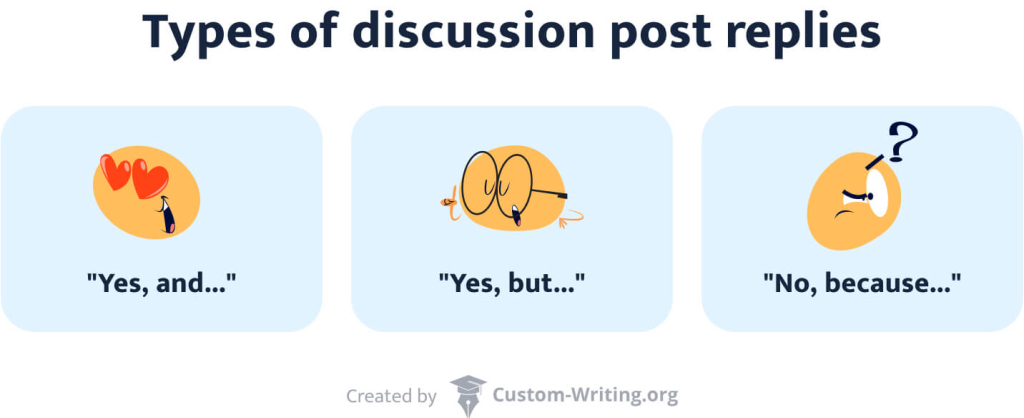Online discussion boards are becoming increasingly popular in schools across the US. These convenient, forum-like platforms allow participants to expand on ideas and share insights. Research by Douglas et al. (2020) shows that using discussion boards boosts student engagement and academic results.
When students respond to posts, they should aim to make their answers engaging and keep the conversation going.
If you need help coming up with a good reply, this article is for you. Here, our custom writing service experts will demonstrate how to respond to a classmate’s discussion post in 3 different ways and avoid pitfalls.
We can also help you do your discussion board post if it is a challenge for you to start the conversation yourself. Our team of experts specializes in writing well-crafted, customized posts that spark a good talk or deepen the discussion. In the following sections, we’ll walk you through different strategies for creating effective messages while avoiding common mistakes.
🚀 What to Do Before You Start Writing a Discussion Board Response
Before you start replying to a discussion post, make sure you follow the steps below:
- Carefully analyze the teacher’s prompt to make sure you got everything right.
- Read all the other responses to the post. This way, you’ll be able to see what others have to say and add to or disagree with their ideas.
- Do your research. Before entering the discussion, it’s best to look up pertinent information on the topic.
Once you’re done with that, you can start working on your discussion board response. If you find yourself troubled about crafting the perfect reply, our discussion board response service can help. We will create a thoughtful, engaging reply that follows your guidelines and contributes meaningfully to the conversation. Whether you need a simple text or one that requires in-depth research, we can provide the support for you to excel in your class discussions.

✍️ How to Reply to Discussion Posts Step by Step
Replying, is in many ways, similar to writing a discussion board post. The biggest difference is that you’re now reacting to and expanding on a specific argument. Here’s how to do it.
Step 1: Starting Your Response
At the beginning of your response, you need to acknowledge the author of the initial post and their contribution. After that, summarize the post’s main idea.
Example:
Thank you for sharing your thoughts on this issue. It’s interesting that you’ve mentioned how social media makes people grow distant and impact their approach to relationships.
Step 2: Expressing Your Viewpoint
After presenting the post’s argument, explain your own perspective, whether you agree or disagree with it. Remember to stay respectful and use credible evidence to prove your point.
Example:
I find your perspective very insightful, but I disagree with a couple of points. While social media has drawbacks, I think benefits are more important in this context.
Step 3: Concluding Your Reply
In the conclusion, summarize all the main points and add some thought-provoking questions for other students. That’ll keep the conversation going.
Example:
All in all, social media has definitely shifted the way people approach each other, but do you think the change is for the better or for worse?
Your response’s contents depend on your opinion of the original post. In the following sections, we will examine the different types of replies you can use to express your viewpoint.
🤔 3 Main Types of Discussion Post Replies
There are three most common ways to respond to a discussion board post:
Below, we will look into each type of response and provide examples. And if you want to get brilliant results easily, try using our free discussion board generator.
How to Respond to Discussion Posts: “Yes, And…”
Use this type of answer if you agree with your classmate’s idea but have more to add. Start by highlighting the aspects that grabbed your attention and then contribute your personal viewpoint. It’s also a good idea to write about the aspects of the topic that weren’t mentioned.
Example:
I agree with your post, mainly that social media makes us put less effort into keeping relationships real. I also want to point out that social media obscures people’s genuine feelings. When you correspond by texting, it becomes hard to “read” people and gauge emotions.
How to Respond to Classmate’s Discussion Post: “Yes, But…”
If there are aspects of a post you disagree with, respond by pointing those out and explaining why you have a differing opinion. Then, you can add your take on the issue.
💡 Tip:
To make the debate more engaging, consider playing the “devil’s advocate” and upholding an unpopular viewpoint. This will help you and other participants confront biases and become more open-minded.
Example:
I agree that social media has made people less willing to maintain and nurture relationships. However, to play the devil’s advocate, I think this doesn’t necessarily mean growing distant from one another. Social media can be helpful by allowing individuals to stay connected despite circumstances that might otherwise have estranged them.
How to Reply to Discussion Posts: “No, Because…”
Even when you disagree with the post, showing your appreciation is essential. Focus on the logic and explain where exactly you see the flaw in the argument. Then, provide your own opinion.
Example:
I see your point, but let me put things in a different perspective. While it can be true that people communicate less in real life, I believe the internet only helps individuals get closer, especially when there are miles between them.
You can find more model answers in our article with discussion post examples.
🙅 How NOT to Reply to Discussion Posts
When you’re writing a discussion post reply, it’s important to avoid common pitfalls. Here’s how to ensure excellent results:
- Refrain from disagreeing with the original poster’s statements without explaining the reason.
- Avoid overusing casual speech. Although discussion posts and replies are less formal than essays, it’s still best to use academic language.
- Don’t use offensive language and generalizations.
- Avoid repeating what has already been said.
- Remember to relate your answers to study materials and learning objectives.
We hope you enjoyed this article and found it helpful. Start practicing using the tips you’ve learned, and use our discussion board generator to improve your replies even further. Good luck!
🔗 References
- Online Discussion Boards: Improving Practice and Student Engagement by Harnessing Facilitator Perceptions: Insitute of Education Sciences
- Common Pitfalls of Discussion Board Responses: University of Nevada, Reno
- Writing a Discussion Board Post: University of Arizona, Global Campus
- Sample Discussion Posts and Replies to Peers: Colorado State University




![How to Write a Research Paper Step by Step [2025 Upd.]](https://custom-writing.org/blog/wp-content/uploads/2020/12/research-charts-284x153.jpg)






